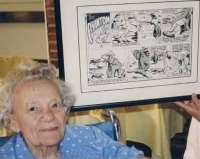Interview - Claire Moore talks about her husband Ray Moore
| Claire Lydia Moore (née Moehlenbrock) | |

| |
| Biographical information | |
| Born: | May 2, 1908 |
|---|---|
| Died: | June 1, 2005 |
| Nationality: | |
| Occupation: | Ray Moore's widow |
| Website: | |
Claire Moore talks about her husband Ray Moore
Claire Moore (is) was an engaging conversationalist, intelligent, modest, endearing and generous with her memories. After learning of her whereabouts, I did a little detective work and was granted permission to speak with her. When I came home from school and heard her friendly voice on my answering machine, I was excited. (Until now) Until that time, the amount of information about Ray Moore had been very scant and the opportunity to learn more had not been very promising. I knew he was an Soldan High School Alum and a native of Montgomery City and that he lived from 1905 until 1984. In a clear, confident voice, Claire began talking about Ray: "He was born in Oklahoma." I remarked that I had only seen one picture of Ray and she explained; "He didn't like to be photographed. All he had was snaps(hots). There are some pictures from when he was in the service." When I asked about his art she remarked; "I have an original drawing of of Ray's of the Phantom on my wall." She confirmed that he was an assistant on the Mandrake strip; "Yes, but not very long. He worked on the Phantom from the very beginning. Ray did the Phantom and followed through (with Lee's writing) and sometimes made changes because he wanted to make it more accurate." She explained her plans for the acreage that she and Ray owned: "Phantom Forest was our home in (Des Peres) I've given that to the conservation department. It is in suburbia but still has foxes and deer. It will be turned over to the conservation dept on my death". When I asked her where she got the idea for Phantom Forest she replied; "It just seemed natural. Although it's an urban area, the creatures are still there.... the turkey, the great horned owl. It was the sort of thing Ray enjoyed." She reminisced about their early times together. "We did a lot of things together. He had a plane and we flew before the war." When I mentioned that Lee recalled contributing to the art for the first two weeks, she responded; "Ray and Lee may have worked together but Ray always drew it for publishing." When asked how much of a hand Ray had in the creation of the Phantom, she recalled; "Ray had a lot to do with it Lee had an idea and together they worked it out." I found it interesting to learn that Ray worked with a group of artists who helped him with the conceptual development of the Phantom's appearance. She explained; "Ray had his own meetings with four or five St. Louis artists who met a few times a week. Lee came occasionally. They discussed it and helped Lee work it out." When I asked about Ray's use of assistants, she explained. "He had one or two people he used to do backgrounds at times but not the main characters, Just to fill in." She mentioned Wilson McCoy as one of the assistants who also did lettering. "Yes, Wilson started with Ray and filled in for him when he was in the service, We knew McCoy's family: They lived here in St. Louis." Her memories of Ray's fellow artists also included other. "They had a studio together with Hugh Hackaday. He did those beautiful animated Christmas windows. He was a very close friend of Ray's his family had a farm we went out there several times." She discussed Ray's training; "He went to Washington University in St. Louis. I think Lee went there and that may be where they met. They had nothing like cartooning; they had only fine arts." She confirmed the painful nerve damage to his face that Ray suffered as a result og the war. "He was a pilot and flew of open cockpit planes. I think that contributed to his problem." I had heard rumors of Ray's interest in fine arts and she recalled that "Early he painted, but he was engrossed with the life we lived." In his later years his health suffered. "He was active but not well. He was a golfer but just an amateur. We used to play together. When we went ut of the city, we took our golf clubs. Althought we never had children, I still have an expanding family. We still get together." She expressed her recollections of his work on the strip: "He promoted The Phantom and helped to get it going. It was his drawing that helped get it started." She was aware of The Phantom's popularity abroad and was delighted that there were still fans; "I'm glad to hear that his memory and his work was appreciated."
- Copy from Ed Rhoades web site (http://edrhoades.com/phantom/claire_moore.htm Link not working!)
- Additional text from "Memories of Ray Moore - Conversation with Claire Moore" (Friends of The Phantom, issue 24, summer 2004)
-
Claire
-
Claire and Judy Mundle

